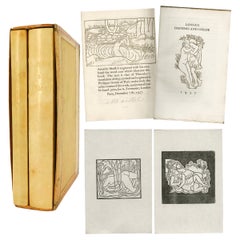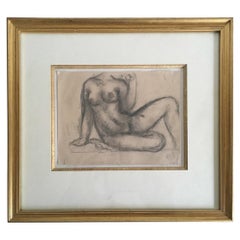Aristide Maillol Furniture
Aristide Joseph Bonaventure Maillol was born in Banyuls-sur-Mer, Roussilon. He decided at an early age to become a painter and moved to Paris in 1881 to study art. After several applications and several years of living with poverty, his enrollment in the Écoledes Beaux-Arts was accepted in 1885, and he studied there under Jean-Léon Gérôme and Alexandre Cabanel from 1882–86. His contemporaries, Pierre Puvis de Chavannes and Paul Gauguin strongly influenced the artist. In 1893, Gauguin suggested he join the artist group "Nabis." Around the turn of the century, the Nabis developed an anti-naturalist, symbolist pictorial language with two-dimensionally-decorative, simplified color shapes and black contours. This style influenced Maillol’s early paintings and tapestry designs. Gauguin had also encouraged his growing interest in decorative art, an interest that led Maillol to take up tapestry design. In 1893, Maillol set up a small tapestry studio at his home village of Banyuls, where he employed local women for weavings and began producing works whose high technical and aesthetic quality gained him recognition for renewing this art form in France. Till 1900, Maillol produced wall tapestries in the Art Nouveau style, but then an eye disease forced him to concentrate on sculpture, mainly small statues made of wood and clay from which he developed his monumental stone and bronze statues. The main subject of his sculptural work was the female nude, which featured a Classic calmness and a clear, closed plasticity. His works done between 1902 and 1905 reveal an approach to classical, statutory forms and his striving for a closed sculptural volume, a harmonious balance and calm classical expression, which was adopted from Hellenistic Antiquity. Aristide Maillol's compact, voluptuous female figures, reminiscent of Gauguin's women as well as of Renoir's later nudes, considerably influenced European and particularly German sculpture. Maillol also produced important graphic works, drawings, lithographs and particularly a series of woodcuts, which the enthusiast for Antiquity made to illustrate antique literature. The first overview of his creations was shown in Paris in 1937, as part of the exhibition "Les maîtres de l'art indépendant," which was held at the Petit Palais simultaneously with the World Exhibition and occupied three rooms. Maillol was awarded large orders, and 1936 - the biggest one of them all, the monumental sculpture "La Montagne" for the then planned Museum of Modern Art in Paris. But these plans were not destined to come true and that makes it possible for his tragic death in a car crash in 1944. Maillol is often remembered as the "Cézanne of sculpture," as he, like Cézanne - paved the way to abstraction.
1930s British Vintage Aristide Maillol Furniture
Paper, Parchment Paper
1880s British Late Victorian Antique Aristide Maillol Furniture
Textile, Paper
Early 20th Century American Bohemian Aristide Maillol Furniture
Paper
Late 20th Century American American Classical Aristide Maillol Furniture
Paper
1960s British Vintage Aristide Maillol Furniture
Leather
21st Century and Contemporary American American Classical Aristide Maillol Furniture
Paper
Early 20th Century British Sporting Art Aristide Maillol Furniture
Paper
21st Century and Contemporary Aristide Maillol Furniture
Paper
1920s American Art Nouveau Vintage Aristide Maillol Furniture
Fabric, Paper
1850s Scottish Victorian Antique Aristide Maillol Furniture
Leather, Paper
1930s English Vintage Aristide Maillol Furniture
Paper
1890s American American Classical Antique Aristide Maillol Furniture
Leather, Fabric, Paper
20th Century American Aristide Maillol Furniture
Paper
20th Century North American Mid-Century Modern Aristide Maillol Furniture
Ceramic, Walnut
Early 20th Century French Aristide Maillol Furniture
Paper
1920s French Art Deco Vintage Aristide Maillol Furniture
Bronze
1910s French Art Deco Vintage Aristide Maillol Furniture
Paper




